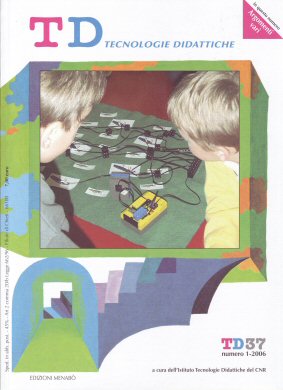"Folksonomies" on the Net: constructing alternative, creative and intercultural categories.
Main Article Content
Abstract
Article Details
Authors who publish with this journal agree to the following terms:
- Authors retain copyright and grant the journal right of first publication with the work simultaneously licensed under a Creative Commons CC BY 4.0 Attribution 4.0 International License.
- Authors are able to enter into separate, additional contractual arrangements for the non-exclusive distribution of the journal's published version of the work (e.g., post it to an institutional repository or publish it in a book), with an acknowledgement of its initial publication in this journal.
- Authors are permitted and encouraged to post their work online (e.g., in institutional repositories or on their website) prior to and during the submission process, as it can lead to productive exchanges, as well as earlier and greater citation of published work (See The Effect of Open Access)
References
Berman S. (1993), Prejudices and Antipathies: A Tract on the LC Subject Heads Concerning People. Metuchen, N.J., Scarecrow Press.
Duncker E. (2002), Cross-cultural usability of the library metaphor, International Conference on Digital Libraries, Proceedings of the 2nd ACM/IEEE-CS joint conference on Digital libraries, Portland, USA.
Eco U. (1984), Semiotica e filosofia del linguaggio, Torino, Einaudi, p.110.
Eco U. (1997), Kant e l’Ornitorinco, Bompiani Ed.
Faggiani G., Russomando P. (1996), Dal mappamondo al planisfero, in AA.VV., L’educazione all’interculturalità, Ega, Torino.
Fisher A.V., Sloutsky V. M. (2005), When Induction Meets Memory: Evidence for Gradual Transition From Similarity-Based to Category- Based Induction, Child Development, May/June 2005, Volume 76, n. 3, pp. 583–597.
Foskett A. C. (1971), Mysogynists all: A study of critical classification, Library Resources & Technical Services, n. 15, pp.117-121.
Frith U., Happe F. (1994), Language and communication in autistic disorders, Philosophical Transactions of the Royal Society, London B., n. 346, pp. 97-104.
Hammond T., Hannay T., Lund B., Scott, J. (2005), Social Bookmarking Tools (I): A General Review, D-Lib Magazine.
Howard R. W. (1987), Concepts and Schemata: An Introduction, Cassell Educational: Taylor and Francis, cap. 1,4,6,7, in Damiano E., (2000) Insegnare i concetti, Armando, p.102.
Jerrewing L. (2005), Chinese library classification: Daoist, Confucian and Maoist influences in five Chinese library classification systems, Master Thesis, University of Hogskolan I Boras, Svezia.
Kanner L. (1946), Irrelevant and metaphorical language in early infantile autism, American Journal of Psychiatry, n. 103, pp. 242-246.
Koch R. (1998), The 80/20 principle: The secret of achieving more with less, New York, Currency.
Labov W. (1973), The boundaries of words and their meaning in C.J.N. Bailiy and R.W. Shuy (eds.) New ways of Analizing Variation in English, vol.1, Washington, Georgetown University Press.
Lakoff, G. (1987), Women, Fire, and Dangerous Things: What Categories Reveal About the Mind, University of Chicago Press.
Marino V. (2004), Classificazioni per il Web, i vantaggi dell’adozione di schemi a faccette, AIB. Accessibile alla pagina: http://www.aib.it/aib/contr/ marino1.htm, (2004-02-02)
Petrucco C. (2002), Costruire mappe per cercare in rete: il metodo Sewcom, TD-Tecnologie Didattiche, n. 25, Menabò, Ortona.
Rosch E. (1973), On the internal structure of perceptual and semantic categories, in Moore T. (Ed.), Cognitive Development and the Aquisition of Language, Academic Press, New York , pp. 111-144.
Scribner S., Cole M. (1973), Cognitive consequences of formal and informal education. Science, n. 182, pp. 553-559.
Spiro R. J., Feltovich P.J., Jacobson M.J., Coulson R.L. (1992), Cognitive flexibility, constructivism and hypertext: Random access instruction for advanced knowledge acquisition in ill-structured domains, in T.M. Duffy, D.H. Jonassen (Eds.), Constructivism and the technology of instruction: A conversation, Lawerence Erlbaum Associates, Hillsdale, NJ, pp. 57-76.
Studwell W.E., Wu H., Wang R. (1994), Ideological influences on book classification schemes in the People’s Republic of China, Cataloging & Classification Quarterly, vol. 19, n. 1, pp. 61-74.
Surowiecki, J. (2005), The Wisdom of Crowds, Anchor Ed.
Varisco B.M. (2004), Portfolio, Carocci, pp. 287-292.
Vuorikari R. (2005), Can personal digital knowledge artefacts management and social networks enhance learning?, Insight, Observatory for new technologies and education, European Schoolnet. Accessibile alla pagina: http://www.eun.org/insight-pdf/ special_reports/social_networks_ learning_vuorikari_9_2005_ insight.pdf
Wayne A. Wiegand (1998), The ‘Amherst Method’: The origins of the Dewey Decimal Classification scheme, Libraries & Culture, Spring, p. 179.
Wenger E. (1998), Communities of practice: learning as social system, in Systems Thinker. Accessibile alla pagina: http://www.co-i-l.com/coil/ knowledge-garden/cop/lss.shtml
Williams R. (1976), Society, Key Words: A Vocabulary of Culture and Society, Fontana Press, London.
Zins C. (2002), Models for Classifying Internet Resources, Knowledge Organization, Vol. 29, n.1.
Zipf G. K (1949), Human behaviour and the principle of least effort, Addison-Wesley, Reading, MA.

